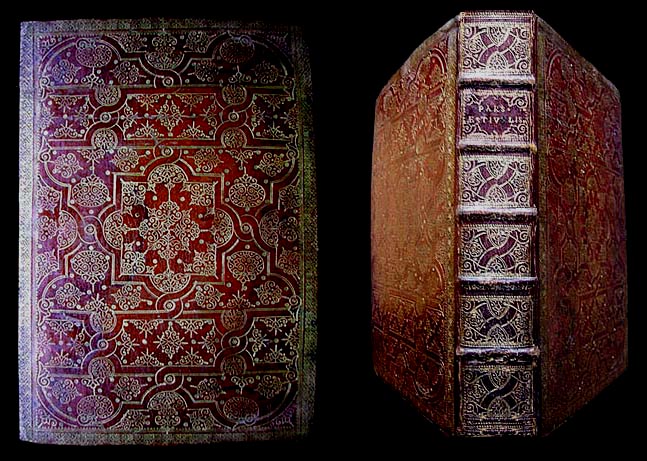

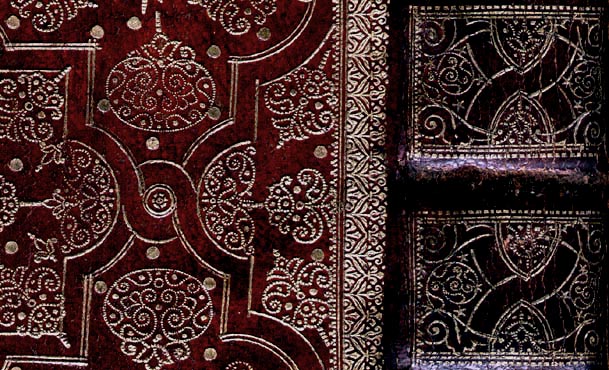
|
Before we start examining the fascinating subject of decorated bookbindings, I should point out the fact that a book may be bound or rebound long after it was published, and therefore the decorative style of a particular binding might not be representative of the period when the book was actually printed. The book shown above was published in 1647, is the decorative style of binding typical of that period? This was one of the first of many unknowns encountered in the study of this extraordinary piece of decorative bookbinding. By a comparative study of gold tooling, I was hoping that I might eventually be able to identify the actual binder of this book and so launched into a study of seventeenth century bookbinding in France Fortunately while searching the internet for clues in this matter I discovered the website aboutbookbinding.com where we find "An Essay in the History of Gold-Tooled Bindings" by Herbert P. Horne London 1894, here we learn an important fact "In France, alone, has bookbinding been continuously practiced, and encouraged, as a fine art, since the Revival of Learning: and in that country, alone, does there exist any considerable literature upon its history and methods. In this sense, bookbinding is an art almost peculiar to France: and yet not to France, but to Italy, must be conceded, both the introduction of gold-tooling into Europe, and the origin of the taste, which determined the nature of the designs used upon European tooled bindings, for nearly a century. Indeed, it might be questioned, whether early Italian bindings have yet been surpassed in beauty and decoration, by those of other times or countries." It seems then that while the Italian styles dominated much of the sixteenth century, in the seventeenth century French Binders were leading the way and this period seems to be dominated by two stylistic trends, the first called "fanfare" which actually emerged in the sixteenth century but was then much elaborated upon in the seventeenth century and the second "pointille". Here is a description of these two terms from another excellent web site.... |
|
fanfare style An elaborate style of decoration consisting generally of geometrically formed compartments of varying sizes, each bounded by a ribbon consisting of a single fillet on one side and a double fillet on the other, each of which, with the exception of the center compartment (which is larger or otherwise distinguished), being filled with leafy spirals, branches of laurel, and other sprays, floral tools..... Fanfare was a rich and luxurious style and called for the greatest skill on the part of the bookbinder. It was imitated, with varying degrees of fidelity, throughout Europe from about 1570 until well into the 17th century, although its elements were largely imitative of previous styles of embellishment. Originally, the style was attributed exclusively to Nicholas and Clovis Ève, but it is more likely that a number of Parisian finishers executed many of these binding. The name "fanfare," which originated long after the style was first executed, derives from a binding of the 19th century binder, JOSEPH THOUVENIN , who revived the style on a volume he bound in 1829, Les Fanfares et Corvees abbadesques. |
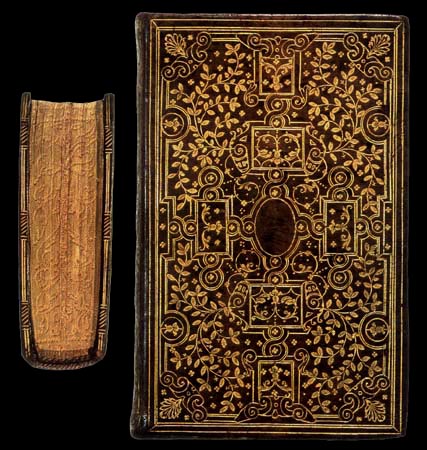
| A "fanfare style" binding in the manner of the Ève brothers on a copy of Horae beatissimae Virginis Mariae. Note the gauffered edge. Printed by Christopher Plantin, Antwerp, 1570. Lessing J. Rosenwald Collection, Library of Congress. (21.2 cm. by 13.2 cm. by 4.5 cm.) |
|
pointillé A luxurious style of finishing consisting of dotted lines and curves impressed on the covers of a book. In the first half of the 17th century, pointillé was used by numerous French bookbinders and/or gilders, including Florimond Badier and Macé Ruette, although in terms of sheer magnificence of execution, it reached its pinnacle earlier in the bindings associated with the name (LE) GASCON |
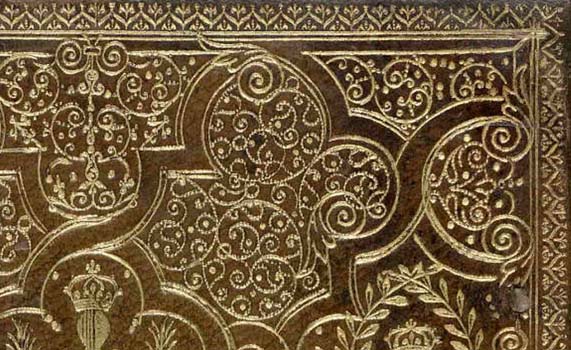
|
Gascon, Le The name associated with a luxurious style of finishing introduced in France in the early 17th century. The "Le Gascon" style, known as "pointillé" , is made up of interlaced bands, enclosing geometrical compartments which are filled with innumerable gold dots, frequently elaborated into lines and curves of remarkable luster and elegance. Over the years many stories have arisen concerning "Le Gascon." One is that he worked as a bookbinder, or, more likely, as a gilder in the Eve's bindery, from which he took the style later to be called FANFARE STYLE (with its complicated geometrical framework) as the basis of his designs, but worked out all of the scrolls in fine dots instead of solid lines. While finishing tools had begun to become more finely cut with the Eves, they reached th pinnacle of delicacy and perfection with the work of this gilder or group of gilders. It has also been suggested that "Le Gascon" was the pseudonym of a famous binder, and it has been argued that the possibility exists that "Le Gascon" was employed by Gaston, Duke of Orleans. Despite the speculation, there are no records to indicate just who "the man" may have been. There are documents indicating that someone going by the pseudonym "Le Gascon" was, as early as 1622, producing the most splendid bindings of that time. It is perhaps only natural that attempts should be made to link this name with the finest of the early pointillé bindings, but to date no binding can be said to he the work of anyone by that name. Three very intricate pointillé bindings, signed by FLORIMOND BADIER , do exist, but since Badier did not even begin his apprenticeship until 1630, he cannot have been "Le Gascon." |
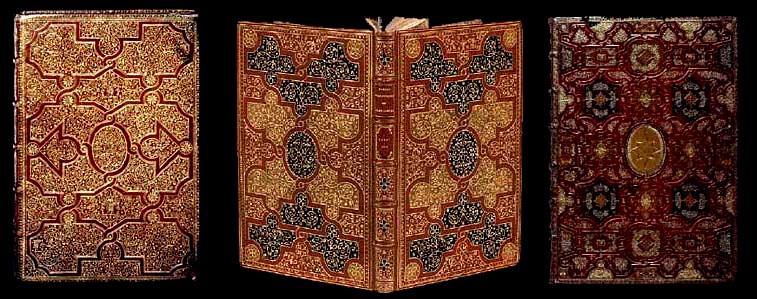
|
Returning now to An Essay in the History of Gold-Tooled Bindings, by Herbert P. Horne London 1894... Further, and of this there can be no doubt, the style of Le Gascon, so-called, was in vogue between the years 1640, and 1665: whereas it appears, from the records of the Guild of St. Jean, that Le Gascon was a binder of acknowledged accomplishment in 1622, that is, some twenty years before the style ascribed to him came into use. Florimond Badier, who is thought to have come to Paris from Gascony, was apprenticed to Jean Thomas, gilder, on the 30th November, 1630. The term of his apprenticeship having expired in 1636, he married the daughter of Jean Gillede, binder, on the 6th July, 1645, and was made free of the Guild of St. Jean, that same year. The date of his death, like that of Le Gascon's, remains unknown. The copy of the Imitation, in the Bibliotheque Nationale, which bears the signature of Badier, is bound in red morocco, inlaid with various coloured leathers, in compartments formed by an interlaced fillet. The doublure is of citron morocco, also, inlaid with differently coloured compartments of the same leather, but designed in a style different from that of the exterior, the fillet being omitted. The signature of the binder is stamped on the upper board, above the tail edge of the doublure: and the whole of the figured work is richly tooled "au pointille", that is, not in solid, but in dotted, lines; by which device, an effect of great brilliance and delicacy is produced [Vue, Gruel's Manuel, s.n.]. The execution of the gilding, M. Thoinan contends in opposition to the opinion of MM. Marius-Michel, is unquestionably skilful; although it does not show that solidity and certainty of handling characteristic of the later bindings, which this writer seeks to attribute to Badier: but it is, without doubt an early production, having probably been executed before Badier was made free of the Guild of St. Jean; and as such, it is an extraordinary production, being superior in workmanship to much contemporary gilding. Tooled upon this binding, and equally remarkable with the signature of Badier, is a couped head, worked "au pointille" like the rest of the figured tools, which is repeated no less than fifty-two times. This head, which is well known from its occurrence upon other bindings, has passed, according to a vague tradition, not only for the mark, but, also, for the portrait, of Le Gascon. |
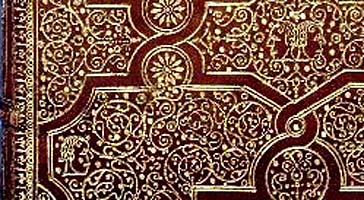
|
Dismissing this tradition as an invention worthy of the predecessors of Edouard Fournier, in the
history of bookbinding, M. Thoinan argues, that this head is the mark of Florimond Badier, and
that all the bindings, which are tooled with it, were executed by him: and he adds not a little to
the force of this argument, when he points out, that the tools used upon the signed binding of
the Imitation, occur, also, upon other bindings, both with and without the couped head. In short,
not only the bindings, which have been popularly ascribed to Le Gascon, but also Badier's
binding of the Imitation, were the production of the same workshop, and were finished with a
common set of tools. The most probable solution of this difficult question would seem to be found in the assumption, that Le Gascon was none other than Jean Gillede, whose daughter Badier married, and to whose trade he succeeded. But having concisely stated this vexed question, it will be more profitable, I think, to discuss the bindings themselves, than to attempt to disentangle the discrepancies of this history. The designs upon these bindings are principally of two kinds. In the more original, the designer, recurring to, and refining upon, the style, which was in vogue at the end of the sixteenth century, and which is popularly associated with name of the Eves, breaks up the field of the boards, by means of an interlaced fillet of three lines, into a series of compartments: and these compartments, he fills with figured work of a conventional character elaborated upon an arrangement of spiral forms, and tooled wholly 'au pointille,' in place of the former laurel branches, and other ornaments. In some examples, this scroll-work covers the whole field of the compartment; as in the copy of the Paradisus Animae Christianae, Cologne, 16#, bound for the brothers Dupuy and stamped with the couped head, which is figured in MM. Marius-Michel's La Reliure Francaise [PI. XII.]. The British Museum possesses a very splendid example of this kind, in a copy of Alonso Chacon's Historia vtriusque belli Dacici a Traiano Cesare gesti, Rome, 1616 [C. 14- c. 12.], .... |

| .... bound in red morocco, inlaid with compartments of citron, olive green, and brown morocco marbled with black; the colours employed by Badier in his binding of the Imitation. The panels of the back are inlaid and tooled in a manner similar to that of the boards. Among the Egerton manuscripts in the same collection, is a Pontificate, bound in red morocco, and finished with similar ornaments [Eg. MS. 1067.]. This binding, which bears the arms, and cypher, of Domenique Seguier, Bishop of Meaux, from 1637 to 1658, is figured in PI. IX. In other examples, the scroll-work but partially covers the field of the compartments: as in the binding of a manuscript, executed by Jarry in 1658, of Adonis, a poem by La Fontaine, which is figured in MM. Marius-Michel's La Reliure Francaise [PI. XIV.J; and, again, on the binding of a Book of Hours executed for Francois I., now in the British Museum [Ad. MS. 18, 853.J. The edges of this volume, which is bound in red morocco, bear a design painted in colours, upon a gold field, and outlined by a series of tooled dots, or points. This method of decorating the edges is characteristic of the richer volumes attributed to Le Gascon: and the edges of the copy of Chacon's History are ornamented in the same way. |
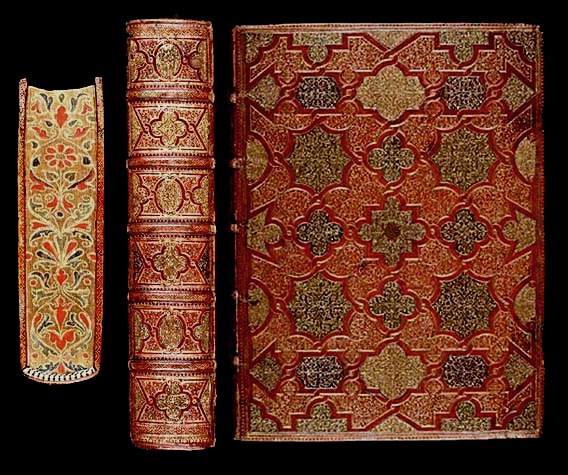
| Go to Digital Alchemy | return to the home page of cyclopaedia.org |